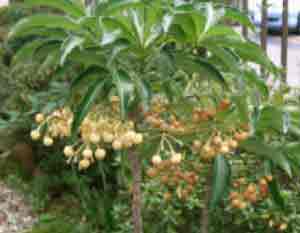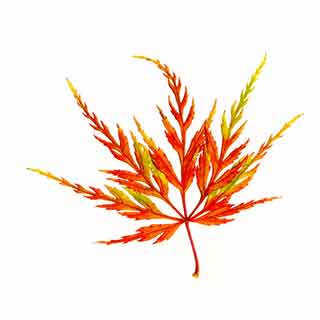

The Plant: This plant looks like a small pretty tree. It has glossy, deep-green leaves, and produces small white or pale pink flowers which then give rise to clusters of coral-red berries. Originates from Asia.
The Ardisia is not the most common of houseplants, but is well worth seeking out if you have space for a largish specimen. A conservatory may be the better site for it - where it can get a good supply of light.
Coral berry will delight you with it's light pink flowers - non-scented- which are then followed for much of the winter with it's coral red berries. A superb and very different Christmas plant present! The winter berries also give it another common name of - The Christmas Berry.
As well as the flowers and berries, it is worth growing as a foliage plant, with pointed spear-shaped leathery leaves. As an outdoor plant, it is evergreen, so if you start to lose many of the leaves indoors, you need to start looking for the real cause.
 Its needs: Good light including morning sun, good air
circulation. Rich, well-draining potting compost. Avoid cold. Bearing in
mind that it is a slightly vigorous shrub growing to 5ft - (1.5m) if
grown well, it will need a decent size pot - and annual re-potting - for
it to remain healthy. A smaller pot can restrict it's size, but there
are many other more suitable smaller houseplants if this is your aim.
Give it room - Make it a feature!
Its needs: Good light including morning sun, good air
circulation. Rich, well-draining potting compost. Avoid cold. Bearing in
mind that it is a slightly vigorous shrub growing to 5ft - (1.5m) if
grown well, it will need a decent size pot - and annual re-potting - for
it to remain healthy. A smaller pot can restrict it's size, but there
are many other more suitable smaller houseplants if this is your aim.
Give it room - Make it a feature!
Feed regularly - but with a weak solution - of general houseplant feed.
I find that a single application of general Osmocote slow release
fertiliser is best - but do NOT overdo it.
Ardisia crenata
Care and Problems of Coral Berry: Water well weekly through growing season. Apply fertilizer once a month during spring and summer. Reduce food and water over winter to prevent new growth which would be susceptible to lower temperatures. Avoid cold. If plant becomes overgrown or straggly cut back main stem in early spring.
If grown outdoors as a shrub (not fully hardy) it rarely suffers and problems - other than those associated with very cold weather.
When grown as an indoor plant, it can suffer from the usual pests, such as red spider mite and mealy bug, though rarely greenfly aphids.
Ardisia can be propagated from seeds or from cuttings.
Seed sowing of Ardisia is best carried out in early spring from the current berry crop. Most important is not to give too much heat - 55 deg F - 12deg C is enough. Much more than this will delay or prevent germination. The seed will germinate quite spasmodically, so after the first seedlings, the tray or pot can be put outside to allow the late starters to develop.
Semi ripe cuttings are probably the best way, if just a few plants are required! This should be carried out in mid-summer.
The Coral Berry is an upright growing shrub, somewhat vigorous, so may well require a little restrictive pruning when grown indoors. This can be carried out in the early part of the year, but will possibly mean a loss of flowers for the summer. Pruning is best treated lightly - trimming some of the untoward shoots and shortening its branches - only if needed.
Good for: This plant can be grown outside in extremely sheltered, frost-free areas, but is better grown indoors or in a conservatory. A sweet little pot-tree.
